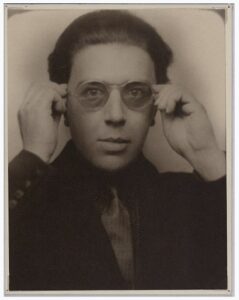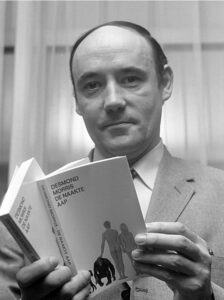Interesting radio programme
Every so often I come across some radio output that brings me up short and make me listen to the end. Actually these days I should probably refer to “audio” or “sounds” rather than radio as the latter is perhaps increasingly considered rather 20th Century. However I refer to radio as that was where I heard it.
I have previously posted about Radio 4’s the Archive Hour. Having said that I have not posted about a programme as bizarre as Matthew Sweet’s exploration of 100 years of the art movement Surrealism in an Archive Hour programme broadcast on the 16th November entitled Lobster Telephone.
 In 1924 artist Andre Breton published the Surrealist Manifesto and set out to “loosen the shackles of rationality and liberate minds”. According to the programme surrealism ought to “upend settled assumptions and change the world”.
In 1924 artist Andre Breton published the Surrealist Manifesto and set out to “loosen the shackles of rationality and liberate minds”. According to the programme surrealism ought to “upend settled assumptions and change the world”.
Having set up the premise and the initial historical fact Sweet then embarks on a programme that sets out to “upend assumptions” and – while not changing the world – perhaps change the way archive radio documentaries can be presented.
It is an hour of radio – or audio – that attempts through its own presentation style to demonstrate what surrealism means. As a result although there are many historical clips from the BBC archives the programme presentation undermines at every turn any attempt to convey a linear narrative or present chronological historical events.
It’s very much a collection of weird soundscapes mixed in with sound effects as well as fragments of archive recordings and contemporary interviews. It’s almost impossible to describe – so you will have to go to BBC Sounds (https://www.bbc.co.uk/sounds/play/m002533s) and log in to hear it if you are interested.
You will hear a collage of sounds and audio fragments including a historical clip that reveals how much Salvador Dali liked money along with chopped up extracts from interviews with contemporary surrealist artists and writers.
 It’s only after about 40 minutes of weird and – obviously surrealist audio – when Matthew is interviewing the “last surrealist” artist still alive (Desmond Morris) that he asks him “what would surrealist radio sound like?”.
It’s only after about 40 minutes of weird and – obviously surrealist audio – when Matthew is interviewing the “last surrealist” artist still alive (Desmond Morris) that he asks him “what would surrealist radio sound like?”.
Of course we already know having heard the previous 40 minutes but Morris replies :
“Well I think if you made this programme in a surrealist style it might be a bit too much for some of your listeners but it might be great fun to try.
To do this you would have to chop up all the things you have been saying and transmit them in a random order – but I don’t think you would be very popular if you did that.”
It’s a moment of meta-textuality in amongst the surrealist audio impressionism – the interview clip explains the intention of the programme and its presentation.
Morris is right – you would not be very popular if all radio (or “audio”) was made this way. It would be confusing and exhausting to listen to – not to mention prohibitively expensive in production time (or was it all produced by a radio production AI?) – but for a programme about Surrealism and whether there is a place for it in the modern world I found it an enjoyable and compelling listen.
 Partly I was marvelling at how well it was put together. When I used to teach students about radio production I would usually refer at some point to the “theatre of the mind” that radio appeals to.
Partly I was marvelling at how well it was put together. When I used to teach students about radio production I would usually refer at some point to the “theatre of the mind” that radio appeals to.
Not true of most radio – but this was piece of radio that did just that – for example we spent several minutes listening to an interview with Perdita Sinclair apparently under water and then “surfaced” to suddenly find ourselves emerging out of the water along with a out of breath Neil Nunes as he linked to the next section. It was surreal – but was it “Surrealist”?
The programme was keen for us to be able to make that distinction. One is a word to describe surprising and incongruous events or images while the other was proper defined art movement that had regular meetings for devotees.
Desmond Morris is probably one of the last people alive who went to actual Surrealist meetings – but then as he explained he was a teenager in World War 2 and is now in his 90s (and still in possession of one of those old style reassuring male RP voices that BBC radio was full of in the 60s and 70’s).
 Surrealism built on and superceded the art movement DaDaism and one of the moments of surreal humour in the programme was a story told by art writer Louisa Buck about the late artist, jazz musician and surrealist George Melley.
Surrealism built on and superceded the art movement DaDaism and one of the moments of surreal humour in the programme was a story told by art writer Louisa Buck about the late artist, jazz musician and surrealist George Melley.
At some point in the 1950’s Melley realised he was about to be mugged and recognising that he was not likely to win a fight against the two would-be assailants started to loudly recite DaDaist Kurt Schwitter’s Ursonate sound poem from 1932 – I’m not going to even try to write it – it’s a succession of nonsensical noises made with the mouth.
Perhaps not surprisingly the muggers ran away!
Check it out here:
I really appreciated the technical aspects of the production of this programme and enjoyed much of the cleverness too but I wondered a couple of times if it came across as just a little bit too pleased with itself.
Still I listened to the end and I’ve listened again to Lobster Telephone as I wrote this. Its weird and surreal radio but I have actually learnt some things I didn’t know, been taken on a sound journey and been well entertained too – so bizarrely Reithian!
Its on BBC Sounds until November 2025.
Chris Radley – Voice Over
Find out how I became a voice over on the about page
You can download my voice over demos from my voiceovers.co.uk profile